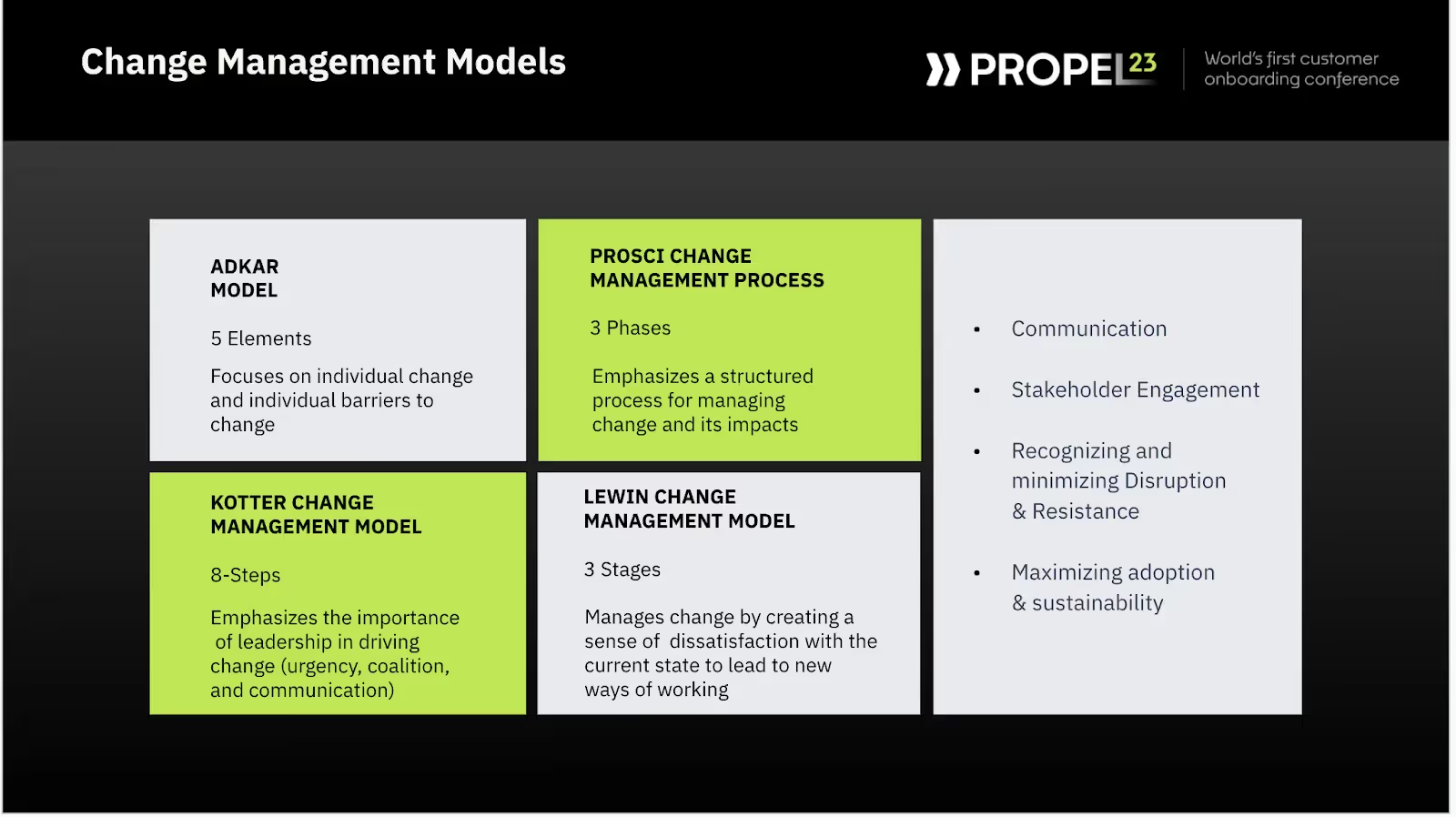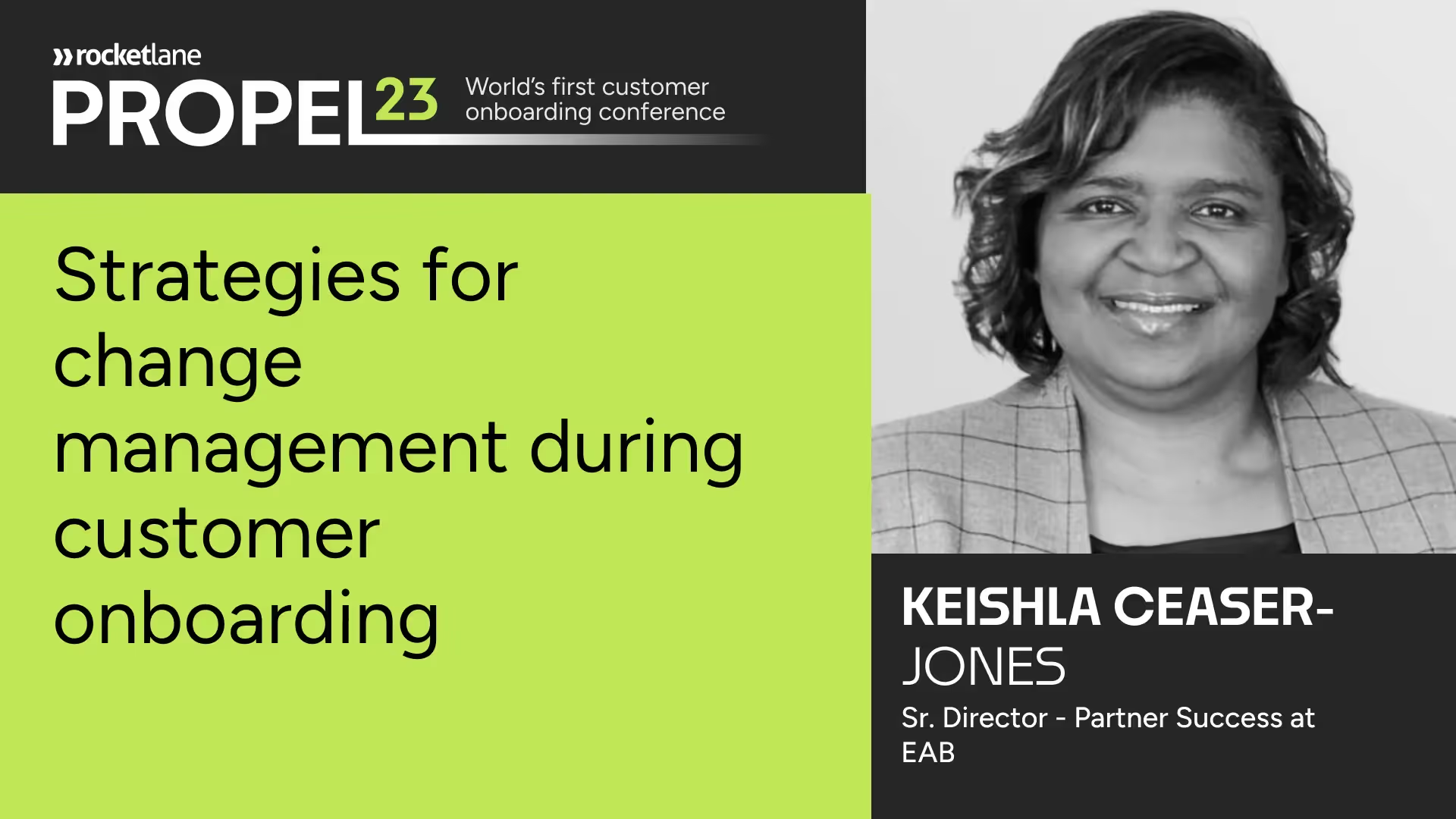Keishla Ceaser-Jones is an accomplished customer success leader currently serving as Senior Director for customer success teams in the higher education sector. Her primary focus is on creating outstanding customer experiences while ensuring maximum value retention and growth. She is also a valued member of Success in Black, an organization dedicated to empowering black professionals in the customer success industry with career guidance and various other offerings
Keishla believes teams that develop competency to guide customers on how to manage change are more agile and resilient. In her session at Propel23, she shared four core strategies for change management during onboarding. She also talked about:
- Change management as a critical skill and why it matters
- Uncovering the current state of change management
- Identifying risks early and planning for resistance
- Equipping your team to deal with change during onboarding
What is change management and why is it a critical skill?
Change management involves the application of structured or systematic approaches designed to facilitate the transition of businesses, teams, or individuals from a current state to a desired, new state. But when you want to move from one place to the next, many things can get in the way and hinder your progress. And you manage them through effective change management.
Why does change management matter?
Change management planning holds significant importance for several reasons. Firstly, it enhances user adoption by emphasizing the purpose behind the change and supporting individuals in transitioning from the current state to the desired state. Secondly, it increases the likelihood of project success by fostering stakeholder buy-in and driving the achievement of deliverables. Additionally, by identifying, planning for, and managing risks, you reduce the chances of resistance, delays, confusion, and missed opportunities. Ultimately, these factors contribute to a boosted return on investment (ROI) through on-time progress and improved time to value, especially with the involvement of stakeholders at appropriate phases of the project.

The different models that can help with change management include:
1. The ADKAR Model
The ADKAR Model places a strong emphasis on individual change. It focuses on identifying and addressing individual barriers to change. This model is particularly useful when dealing with large end-user bases, aiming to get people more accustomed to change.
2. The PROSCI Change Management Process
The PROSCI model uses three phases, and provides a structured approach to managing change and its impacts. It offers a comprehensive framework for understanding and implementing change initiatives.
3. The KOTTER Change Management Model
The KOTTER model comprises eight steps and highlights the significance of leadership in driving change. It is particularly beneficial for top-down implementations, where strong leadership is crucial for successful change management.
4. The LEWIN Change Management Model
The LEWIN model focuses on creating a sense of dissatisfaction with the current state to facilitate the adoption of new ways of working. It is effective when encouraging people to let go of established practices and embrace new products, processes, or solutions.
The ADKAR, KOTTER, PROSCI, and LEWIN change management models all focus on understanding and managing the human side of organizational change. They recognize that effective change management requires attention to the emotions, attitudes, and behaviors of individuals and groups affected by the change. They also all recognize that change is not a one-time event but is rather an ongoing process, and as such, emphasize the importance of continuous improvement and learning to ensure the sustainability of the change effort.
While change management models may differ in their approaches, they share some common aspects, namely a)effective communication, b) stakeholder engagement c) anticipating potential disruptions
7 steps for effective change management
- Understand where your product fits in your customer’s overall ecosystem: Position your product strategically within the larger context of your customer's workflow and objectives. Identify how your solution complements or enhances existing practices and tools for your customers and partners. Gain a comprehensive understanding of the ecosystem to effectively align your product.
- Identify the current practices that your solution will replace, augment, or extend: Assess the current processes and workflows your solution aims to transform for the customer or partner. Determine how your product can substitute, augment, modify, or redefine existing practices for them. Pinpoint the specific areas where your solution adds value and addresses pain points.
- Determine the stakeholders who will intersect with your solution from top to bottom: Broaden your perspective beyond end users to include all key stakeholders involved. Identify cross-functional teams and individuals who may impact the implementation. Recognize potential roadblocks and leverage supporters to drive successful adoption.
- Get agreement on the expected changes, their prioritization, and management: Establish a shared understanding of the necessary changes and their importance. Prioritize and manage changes effectively to avoid overwhelming stakeholders. Foster consensus and align goals to create a smooth transition process.
- Put yourself in your customer’s shoes: Understand your partner's goals, challenges, and pain points. Consider their perspectives when designing and implementing your solution. Tailor your approach to meet their needs and create a mutually beneficial partnership.
- Practice active listening: Listen attentively to your customers and partners to grasp their concerns and feedback. Create a safe space for open dialogue and encourage honest communication. Demonstrate a genuine interest in their opinions and ideas.
- Ask probing questions that identify the current state, root issues, and needs: Use insightful questions to uncover the current state of affairs and challenges. Probe deeper to identify the underlying root causes and pain points. Understand the specific needs and requirements of your customers and partners.
By following these seven practices, you can navigate change management with confidence, ensuring successful implementation and long-term relationships with your customers and partners.
Identifying risks early and planning for resistance
Identifying risks early on and planning for resistance are crucial aspects of change management. By doing so, you can reaffirm project goals, solidify the scope and timeline, and utilize appropriate stages as needed.
A common challenge in implementation processes is that stakeholders may be experiencing the change for the first time. Therefore, it is essential to provide clarity and help them understand the decision-making process and how each decision relates to the overall journey. Transparency about the destination and the milestones along the way keeps stakeholders engaged and prevents them from feeling lost or resistant to the change.
Understanding project dependencies is also vital in uncovering risks. Recognizing which decisions can impact the next phase's progress allows for proactive planning and mitigating potential issues. Additionally, identifying the right stakeholders to involve in meetings and ensuring their timely participation helps maintain focus and address risks effectively.
Risks may manifest as busy schedules, key meeting absences, communication blocks, delays in deliverables, failure to make progress-driving decisions, or constantly changing goals. Recognizing these risk indicators is essential in managing change, and it necessitates proactive planning and preparation for the identified risks.
Equipping your team to deal with change
Goal alignment
To ensure teams are prepared for change, goal alignment is crucial during handoffs from sales to implementation and onboarding teams.
Categorize product value alignment with partners' goals and identify reasons for purchase. Request the sales team to provide this information during the handoff. Share these reasons on kickoff calls and align them with goals. Use these goals to create playbooks for implementation and decision-making. The idea here is to capture compelling reasons for purchase early on, enabling the refinement of partner onboarding and the creation of effective implementation playbooks.
Risk intervention
Make sure you and your customer or partner know what to do when risk is identified. Develop a risk escalation strategy. Decide in advance what will occur if deadlines aren't met, so everyone knows how to move forward. When things don't go as planned, create an environment of understanding so you can effectively work with your customer. Establishing norms and practices for engaging with them will help to ensure smooth sailing.
Communication tools
Develop communication templates that can be shared with partners to inform their internal stakeholders about upcoming changes or new developments. Often, during calls or meetings, stakeholders may express confusion or lack of awareness regarding the purpose of the purchase.
Therefore, it is essential to proactively plan how partners can effectively communicate with their internal teams, breaking down silos and ensuring everyone is informed about the impending change. Additionally, identifying key milestones throughout the change process provides opportunities to celebrate progress, fostering a positive and supportive environment.






















.webp)
